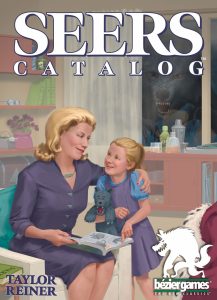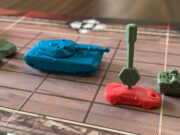 Last year at a wonderful sort-of local trick taking game weekend, I had the pleasure of learning and playing Of What’s Left. Featuring the cutest little owl art you can imagine, it’s was a unique take on a hand shedding game like Tichu or Scout. Unfortunately for everyone, it was pretty tough to get a copy of having only been published in Japan.
Last year at a wonderful sort-of local trick taking game weekend, I had the pleasure of learning and playing Of What’s Left. Featuring the cutest little owl art you can imagine, it’s was a unique take on a hand shedding game like Tichu or Scout. Unfortunately for everyone, it was pretty tough to get a copy of having only been published in Japan.
What does that have to do with Seer’s Catalog? Well, it’s basically the same game. But now published state-side by Bezier games along with some added special abilities and, of course, a werewolf-adjacent theme. No owls here, they’ve all been eaten by the werewolves I guess.
Gameplay Overview:
If you’ve played a shedding game, you probably will get the just of Seers Catalog right away. You start with a hand of cards and your goal is to get rid of them almost. Most games have you trying to the first one out. Generally speaking, in Seers Catalog you want to be almost out of cards when another player goes out.
The player who leads can play a single card, any number of cards of the same value, or a run of sequential cards of the same suit. Clockwise from there, the other players must play a higher value of the same type of meld. So if the leader plays three 7’s, the next player must play 3-of-a-kind of 8 or higher.

Once a player is out of cards the round ends. The player who went out scores 0 points. Any player with 5 or fewer cards in their hand gets bonus points equal the the lowest value left. And then all players lose one point for every card in their hand. So at the end of the hand, if you have just an 8 and 10 left, you get 8 bonus points and then lose 2, netting 6. However if you have 6 or more cards you are just getting negative points, no bonus for you!
All of that scoring explanation to get to the tricky part. For most of the hand, you can voluntarily pass even if you have a way to beat the current meld. Once you have 5 or fewer cards and are able to get bonus points you lose that option and you must play if able. So getting down on cards early can be a problem as you may be working to make additional plays and lose those precious bonus points.
Players all start with a wild card and two artifact cards with special abilities. If you end with one in your hand you get 0 bonus points so you are risking a lot if you don’t play them quickly.
After three rounds the player with the most points wins.

Game Experience:
Like most trick-taking and card-shedding games, Seers Catalog is built on a very familiar foundation. The whole idea of being not the first one out but being nearly out is a pretty simple change to the ruleset. Of course that necessitates having some rules about when you can or can’t pass, but it’s worth the rules overhead.

Of course, you want to keep higher-value cards in your hand because you get bonus points based on the lowest value. But when you aren’t able to pass, having a hand of high cards is particularly dangerous. And if you have pairs or suited runs you can get yourself forced to play. Success in Seers Catalog really requires sculpting a hand that isn’t going to get decimated in the later rounds.
Often that means keeping around some lower value cards. There is a real risk/reward equation that you have to work out and often comes down to looking around the table and seeing how close other folks are to going out.
Of course, if you have a really strong hand of sets and runs you could just try to speed-run going out first. You won’t score any points, but you’ll saddle everyone else with losing a bunch. And that’s basically just as good. Now if you get stuck without the lead and can’t play for a while you may regret that decision as the hand plays out.

We haven’t yet touched on the artifact cards. The original design, Of What’s Left, just had four special ability cards that basically mirrored what you see in Tichu. Seers Catalog gives us 15 different artifact cards. Some have cool abilities like taking cards out of the trick and putting them back in your hand. Others are pretty straightforward and just give you the opening play or are a wild 5-value card.
For the most part, I preferred the simplicity of having fewer special cards to worry about. It’s imperative players read and understand their artifact cards at the start of their hand or they could be stuck without any real way to play them at the end. But I can see some benefit to having more options as you get more experienced with the game. And I suppose you can just always ignore the rules and play with the original special cards (as long as you don’t have a 5th player, which is also added as an option in Seers Catalog).
Final Thoughts:
Seers Catalog is a great addition to my shelf of small box card games. While I miss the cutesy owl art there isn’t really any other downside to this newer reskin. It accommodates a fifth player and allows some added variability with a lot more artifact cards.
There is a fun ability to really risk a lot by holding onto big cards and gives you the ability to both come back from a big deficit and also have some fun swingy moments hoping you don’t lose your last card in hand. It’s great to see someone manage to hold onto a 10+ value card at the end. But it’s more fun to make them play it just when they thought they were safe.
Final Score: 4 Stars – A fun switch up on card shedding rules gives players a lot more to consider.
 Hits:
Hits:
• A familiar premise with just a small change in rules
• Lots of opportunities to take risks for big points.
Misses:
• Some artifacts can be confusing and if ignored too long can get stuck in your hand.
• All those cute owls died I guess






















Cheers for the review, Andrew!
So awesome to read!!